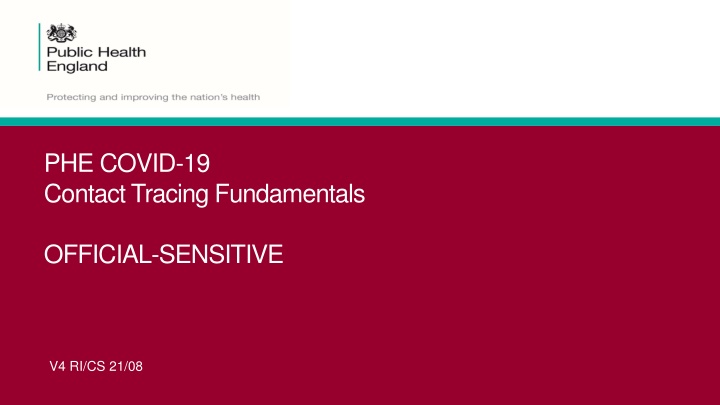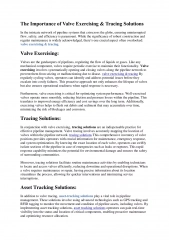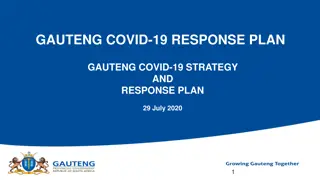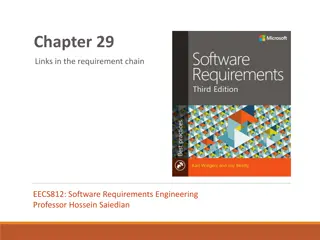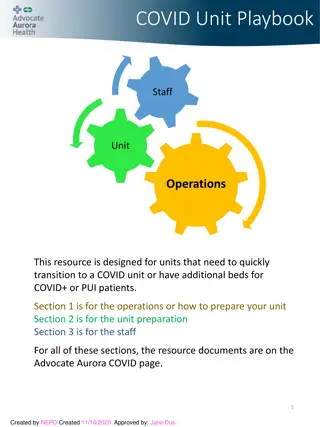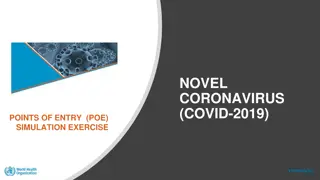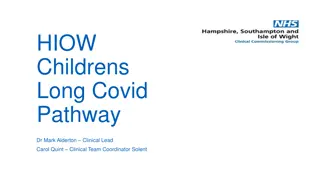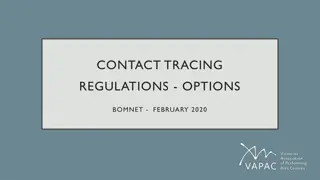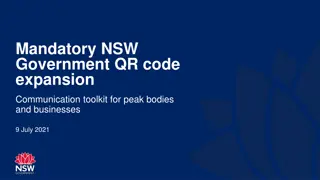National COVID-19 Contact Tracing Fundamentals and Operations Overview
The document provides detailed information on the structure and operations of the national COVID-19 contact tracing in England, involving Tier 1, Tier 2, and Tier 3 contact tracing levels. It covers topics such as the role of different tiers, escalation criteria, infectious and incubation periods of COVID-19, breaking the chain of infection, control measures, and important considerations for local authorities. The document emphasizes the importance of contact tracing in controlling the spread of COVID-19 and outlines the responsibilities of each contact tracing tier.
Download Presentation

Please find below an Image/Link to download the presentation.
The content on the website is provided AS IS for your information and personal use only. It may not be sold, licensed, or shared on other websites without obtaining consent from the author.If you encounter any issues during the download, it is possible that the publisher has removed the file from their server.
You are allowed to download the files provided on this website for personal or commercial use, subject to the condition that they are used lawfully. All files are the property of their respective owners.
The content on the website is provided AS IS for your information and personal use only. It may not be sold, licensed, or shared on other websites without obtaining consent from the author.
E N D
Presentation Transcript
PHE COVID-19 Contact Tracing Fundamentals OFFICIAL-SENSITIVE V4 RI/CS 21/08
This slide set will cover: The structure of the national COVID-19 contact tracing operations Escalation criteria Contact tracing fundamentals What is Contact Tracing/Why do it? What/who is a contact? Infectious period for Covid19 Incubation period for Covid19 Breaking the chain of infection Basic control measures Important considerations for Local Authority Tier 1 contact tracing COVID-19 Contact Tracing: mandatory training clinical and information governance OFFICIAL SENSITIVE 2
The structure of the national Covid-19 contact tracing operations In England we have a national contact tracing model called NHS Test and Trace which consists of 3 distinct Tiers. Tier 3 Contact Tracing - The majority of initial public contacts i.e. people who have developed coronavirus symptoms will be asked to contact NHS Test and Trace where the communication of advice to contacts will commence. Tier 2 Contact Tracing Is supported by a team of professional staff who will interview cases and identify contacts. Tier 1 Contact Tracing Is a partnership between the PHE Health Protection Team and Field Service Team, working in partnership with Local Authorities. This tier will deal with complex cases escalated by Tier 2. COVID-19 Contact Tracing: mandatory training clinical and information governance OFFICIAL SENSITIVE 3
OFFICIAL SENSITIVE Operating model ROLES PHE Protocols, Standard Operating Procedures and scripts Tier 3 contact tracing: communication and provision of advice to contacts according to SOPs and scripts. Escalation of difficult issues to tier 2 Tier 3: Contact Tracing callers Tier 2 contact tracing: interview of cases and identification of contacts. Escalation of complex issues to tier 1 Tier 2: dedicated professional contact tracing staff Tier 1 contact tracing: development of guidance and protocols and clinical governance. HPTs and FS working with local authorities as usual to investigate and control outbreaks and other complex issues Contact Tracing team leads recruited / seconded as additional staff into PHE to work with tiers 2 and 3 Regionalised network: overview of the programme regionally Local authorities: shielding, food and support, enforcement, economic impact, workforce impact, community engagement ,schools Tier 1: HPTs, FS, Border health working with LAs Regionalised network with a named Local Authority lead OFFICIAL: SENSITIVE 4
Escalation criteria Current escalation Categories: Cases where liaison with an educational/childcare setting or employer may be required Complex and high-risk settings Care home staff and residents Healthcare workers and emergency workers Cases who attended healthcare settings as non-covid patients Cases living or working in prisons Cases in attending or working in special schools Small vehicles Specified activities or any workplaces where direct contacts are not identified or where 1+ case matched to postcode in disease frequency or severity that may require further investigation Number of cases linked to a specific workplace NB this is likely to change as the pandemic evolves
What is Contact Tracing? Process of systematically identifying individuals who may have come into contact with an individual or a group with an infectious disease, notifying them of their contact status and collecting information to assess their level of risk Contact tracing may also involve collecting further information on individuals a case s contact has come into contact with e.g. when a contact of a confirmed case also reports symptoms when they are contacted by the contact tracing team.
Why do this? The primary aims of contact tracing are: Rapidly identify individuals at risk of infection Prevent onward transmission of the disease through Testing of contacts when necessary Advising contacts on what to do if they have or develop symptoms Advising contacts on ways to minimise potential transmission to others
Who is a contact ? A contact is an individual who has come into contact with a case during their infectious period and whose contact puts them at risk of infection For respiratory diseases that are transmitted person-to-person like Covid-19 we typically use 3 categories for defining contacts Household contact individuals currently living with or normally reside with the case High risk contacts individuals who have spent a significant amount of time in close contact with the case, or had types of contact (for example, healthcare workers performing certain procedures in some circumstances that puts them at high risk of infection Low risk contacts individuals who have spent time with the case, but for whom the type of contact put them at lower risk of infection
Key Health Protection principles - The infectious period? The period of time where someone is infectious to others i.e. can pass the infection on in their coughs and sneezes In some diseases, including COVID-19, you may be infectious before your symptoms develop In some diseases symptoms may last longer than the infectious period This determines how long a case should be isolated for With Covid-19 most people will be infectious for up to 10 days from the onset of their symptoms
Key Health Protection principles - The incubation period? The period of time between catching the virus and developing symptoms i.e. fever, cough etc This determines when a contact may develop symptoms and therefore how long a contact should be isolated for With COVID-19 the average incubation is 5 day with a range of 2- 11 days
Breaking the chain of infection The chain of infection can be successfully broken where we can rapidly find contacts and support them to isolate effectively from other people. Contract tracing is a vital process that supports important public messaging around self-isolation and testing (if symptomatic), physical/social distancing, effective handwashing, face coverings, PPE and effective waste management etc.
Basic control measures Self-isolation is a highly effective way of breaking the chain of infection and therefore is crucial to minimising the onward transmission of the virus. A contact tracer will typically request the self-isolation of individuals that have been in close contact with a confirmed case. Examples of close contact include: close face to face contact (under 1 metre) for any length of time including talking to them or coughing on them being within 1 to 2 metres of each other for more than 15 minutes including travelling in a small vehicle spending lots of time in your home, such as cleaning it
Basic control measures If the person developed symptoms, they should get a test to check if they have coronavirus as soon as possible. Symptoms include: (a high temperature, a new, continuous cough, or a loss or change to your sense of smell or taste), the test needs to be done in the first 5 days of having symptoms. If the personal has symptoms, they should stay away from other people they live with as much as possible. If they can: stay in one room as much as possible and keep the door closed avoid using shared spaces (such as the kitchen) at the same time as other people eat their meals in their own room use a separate bathroom - otherwise, use the bathroom after everyone else and clean it each time it is used, for example, by wiping the surfaces they have touched
Important considerations for Local Authority Tier 1 contact tracing Contact Tracing involves requesting and collecting personally identifiable data therefore anyone supporting the process in communities must be trained on Data Security/General Data Protection Regulations to the minimal level specified the host organisation. Confirmed cases have a right to ensure that their personal details (including name) are not given to any other contact being traced. Scam prevention has rightly been an important focus of the NHS Test and Trace function, where contact tracing takes place outside of the NHS Test and Trace system, additional safeguards and reassurance need to be in place to reassure the public that the call is genuine. It will be important that you are able to provide a recognised contact telephone number e.g. a council contact centre. The contact should be able to verify the authenticity of the call.
Please see Contact Tracing skills and conversations slide set for information on how to conduct contract tracing 15
